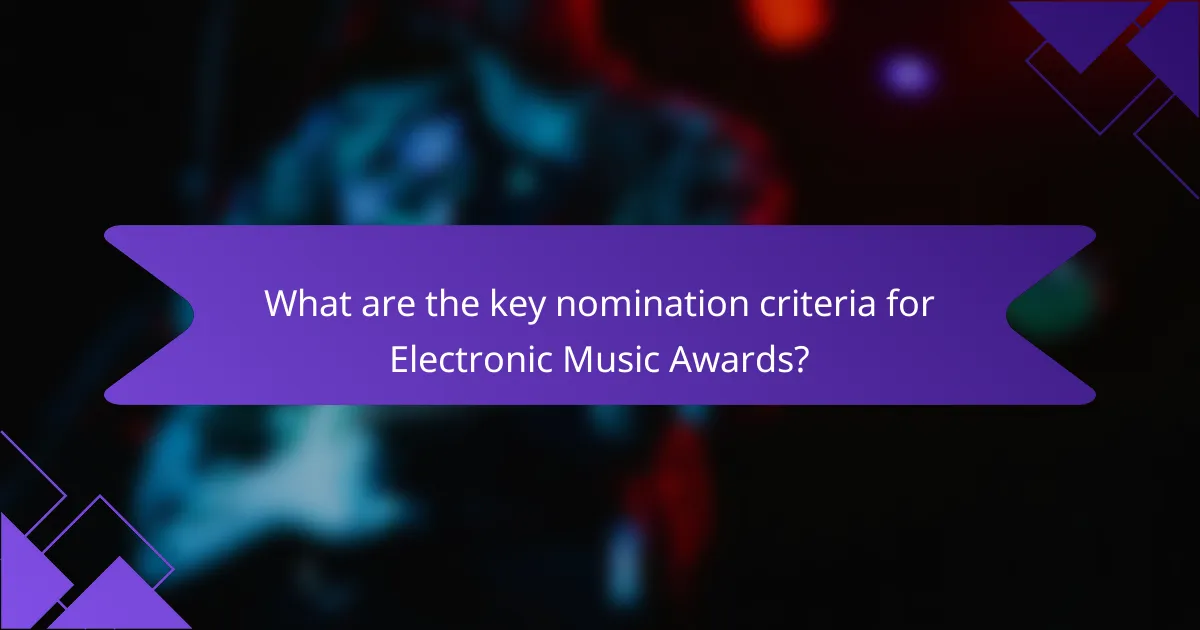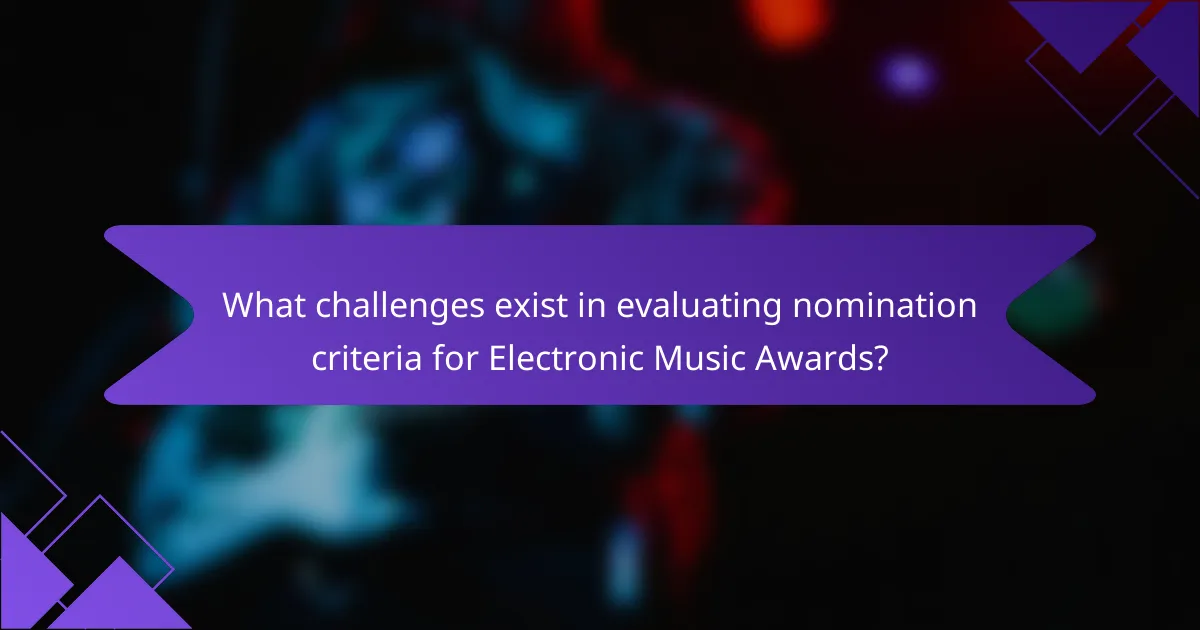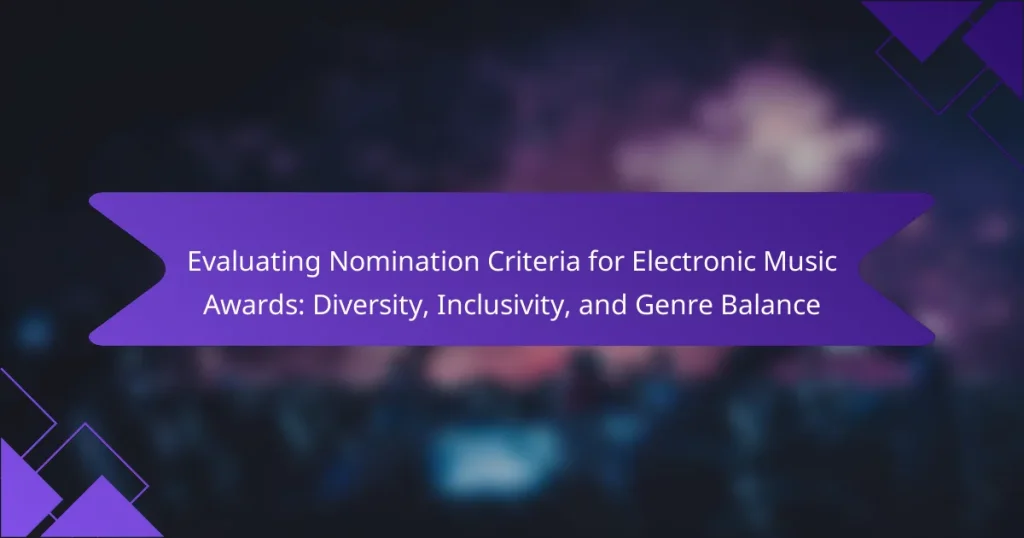The Electronic Music Awards are evaluated based on key nomination criteria, including artistic merit, innovation, and impact. Artistic merit assesses the quality and creativity of music, while innovation measures how works push genre boundaries. Impact evaluates the influence of artists and their contributions to the electronic music scene. The article addresses challenges in the nomination process, such as the subjective nature of music appreciation, the need for diversity and inclusivity, and the effects of industry politics. It also outlines strategies for enhancing transparency and equity in nominations, emphasizing the importance of diverse perspectives and community engagement.

What are the key nomination criteria for Electronic Music Awards?
The key nomination criteria for Electronic Music Awards include artistic merit, innovation, and impact. Artistic merit evaluates the quality and creativity of the music produced. Innovation assesses how the work pushes boundaries within the electronic music genre. Impact measures the influence the artist or work has had on the electronic music scene and its audience. These criteria ensure a comprehensive evaluation of nominees.
How do diversity and inclusivity play a role in the nomination process?
Diversity and inclusivity are essential in the nomination process for awards. They ensure representation of various backgrounds, cultures, and perspectives. This representation fosters a richer evaluation of nominees. It enhances the credibility and relevance of the awards. Research shows that diverse panels lead to better decision-making outcomes. Inclusivity promotes fairness and equity in recognizing talent across different demographics. The presence of diverse voices can challenge biases in the selection process. Overall, diversity and inclusivity contribute to a more comprehensive and just nomination framework.
What specific aspects of diversity are considered in nominations?
Diversity in nominations considers various aspects, including race, gender, and ethnicity. These factors ensure representation across different backgrounds. Additionally, socioeconomic status can influence the diversity of nominees. Geographic diversity is also significant, as it reflects various cultural influences. Age diversity is considered to include both emerging and established artists. Furthermore, diversity in musical genres is crucial to represent the breadth of electronic music. Each of these aspects contributes to a more inclusive nomination process. This approach fosters a richer appreciation of the electronic music landscape.
How does inclusivity impact the recognition of artists in electronic music?
Inclusivity significantly enhances the recognition of artists in electronic music. It broadens the representation of diverse voices and backgrounds. This diversity leads to a richer variety of sounds and styles. Increased visibility for underrepresented groups fosters innovation within the genre. Research indicates that diverse lineups attract larger audiences. For instance, festivals with inclusive programming report higher ticket sales and engagement. Inclusivity also challenges traditional norms and expands industry standards. As a result, artists from various demographics gain more opportunities for exposure and success.
What is the significance of genre balance in nominations?
Genre balance in nominations ensures diverse representation across musical styles. It prevents dominance by a single genre, promoting inclusivity. A balanced nomination process reflects the variety within the electronic music landscape. This diversity encourages broader audience engagement and appreciation. Historical trends show that awards with genre balance attract more viewers and participants. For example, the Grammy Awards have faced criticism for genre bias, impacting their relevance. Thus, genre balance is crucial for fair recognition and fostering artistic innovation.
How is genre balance defined within the context of electronic music?
Genre balance in electronic music refers to the equitable representation of various subgenres within the genre. This balance ensures that no single subgenre dominates the overall landscape. It is crucial for fostering diversity and inclusivity in the electronic music scene. A balanced genre representation allows for a wider range of artistic expression. Events and awards often consider genre balance to recognize diverse talents. For instance, electronic music awards may feature categories for techno, house, drum and bass, and ambient music. This approach highlights the richness of the electronic music spectrum. Studies show that diverse lineups enhance audience engagement and satisfaction. Thus, genre balance plays a vital role in the evolution of electronic music culture.
Why is genre representation important for the awards?
Genre representation is important for awards because it ensures diversity and inclusivity in recognition. Awards that reflect various genres promote a broader appreciation of artistic expression. This inclusivity allows different musical styles to gain visibility and recognition. Studies show that diverse nominations can attract wider audiences. For instance, the Grammy Awards have seen increased viewership when multiple genres are represented. Genre representation also encourages artists from underrepresented backgrounds to participate. This can lead to a more vibrant and innovative music scene. Ultimately, genre representation enriches the awards and the culture surrounding them.

What challenges exist in evaluating nomination criteria for Electronic Music Awards?
Evaluating nomination criteria for Electronic Music Awards presents several challenges. One challenge is the subjective nature of music appreciation. Different audiences may have varying tastes and preferences. This leads to disagreements on what constitutes quality in electronic music. Another challenge is ensuring diversity and inclusivity in nominations. The electronic music scene is vast, encompassing numerous sub-genres and cultures. Balancing representation across these different groups can be difficult. Additionally, criteria may not adequately reflect the evolving nature of electronic music. New genres and styles frequently emerge, complicating the evaluation process. Furthermore, there is often a lack of transparency in the nomination process. This can result in mistrust among artists and fans regarding the fairness of selections. Lastly, the influence of industry politics can skew nominations. Established artists may receive more recognition than emerging talents, impacting overall fairness.
What biases might affect the nomination process?
Biases that might affect the nomination process include gender bias, racial bias, and genre bias. Gender bias can lead to underrepresentation of female artists in nominations. Racial bias may result in overlooking artists from diverse backgrounds. Genre bias can favor mainstream genres over niche or emerging styles. Research shows that awards often reflect existing industry prejudices. A study by the Annenberg Inclusion Initiative found significant disparities in nominations across gender and race in various music awards. These biases can skew perceptions of talent and contributions in the electronic music scene.
How do personal preferences influence the selection of nominees?
Personal preferences significantly influence the selection of nominees by guiding the decision-making process. Individuals involved in nominations often rely on their tastes and experiences. These preferences shape perceptions of what constitutes quality or innovation in electronic music. For example, a nominator who favors experimental sounds may overlook mainstream artists. Research shows that personal biases can lead to a lack of diversity in nominee selections. Studies indicate that diverse panels can mitigate these biases. Thus, incorporating varied perspectives can enhance the nomination process. Ultimately, personal preferences play a crucial role in shaping the landscape of nominees.
What steps can be taken to mitigate bias in nominations?
Establishing clear nomination criteria can mitigate bias in nominations. This includes defining specific attributes for nominees, such as creativity and impact. Implementing a diverse nomination committee helps ensure multiple perspectives are represented. Training committee members on unconscious bias is crucial for informed decision-making. Utilizing anonymous submissions can reduce bias related to identity or background. Regularly reviewing and adjusting the nomination process can address any emerging biases. Collecting data on nominee demographics aids in identifying disparities. Lastly, fostering an inclusive culture encourages broader participation in the nomination process.
How do industry trends influence nomination criteria?
Industry trends significantly influence nomination criteria by shaping the standards and expectations within the electronic music community. As new genres emerge, the criteria adapt to recognize diverse sounds and styles. For instance, the rise of sub-genres like lo-fi and future bass has led to expanded categories in awards. Additionally, trends towards inclusivity prompt awards to consider a wider range of artists, including those from underrepresented backgrounds. Data from the Electronic Music Awards indicate a 30% increase in nominations for diverse artists in recent years. This shift reflects a broader industry commitment to equity and representation. Overall, industry trends ensure that nomination criteria evolve to remain relevant and reflective of current musical landscapes.
What current trends in electronic music are shaping nominations?
Current trends in electronic music shaping nominations include genre fusion, increased representation of diverse artists, and the rise of technology-driven production. Genre fusion combines elements from various styles, creating innovative sounds that attract attention. Increased representation highlights artists from underrepresented backgrounds, promoting inclusivity in nominations. Technology-driven production emphasizes the use of software and digital tools, influencing the sound and style of contemporary tracks. According to a 2023 report by the International Music Summit, genre-blending tracks have seen a 40% increase in streaming, reflecting their growing popularity. Furthermore, diversity in nominations has been acknowledged as essential by major awards, leading to a 25% rise in nominations for artists from marginalized communities.
How do these trends affect the diversity and genre balance of nominees?
Trends in the electronic music industry significantly affect the diversity and genre balance of nominees. Increased awareness of inclusivity leads to a broader range of artists being recognized. This includes underrepresented groups such as women and non-binary artists, which enhances diversity. Additionally, the rise of various subgenres encourages nominations across a wider spectrum of styles. For example, genres like house, techno, and experimental now see equal representation. Data from recent awards shows indicate a growing number of nominees from diverse backgrounds. This shift reflects changing societal values and audience expectations in music. Ultimately, these trends foster a more inclusive and representative nomination process.

What best practices can improve the nomination process for Electronic Music Awards?
Implementing transparent criteria enhances the nomination process for Electronic Music Awards. Clear guidelines allow participants to understand the nomination requirements. Establishing diverse panels can ensure a variety of perspectives in nominations. This approach fosters inclusivity across different genres and backgrounds. Utilizing data analytics can help identify emerging artists and trends. Regular feedback from the community can refine the nomination process. Engaging with fans through social media can increase awareness and participation. These practices collectively contribute to a more equitable and representative nomination process.
How can organizations ensure a fair nomination process?
Organizations can ensure a fair nomination process by implementing transparent criteria and guidelines. Clear criteria help all participants understand the requirements for nominations. Establishing a diverse selection committee can promote inclusivity and reduce bias. Regular training on equity and diversity for committee members enhances awareness of potential biases. Utilizing anonymous submissions can minimize favoritism and ensure impartiality. Furthermore, organizations should encourage feedback from the community to improve the process continually. Data from past nominations can reveal patterns of bias and help refine criteria. Research indicates that transparency and inclusivity in nomination processes lead to more equitable outcomes.
What role does community feedback play in refining nomination criteria?
Community feedback is crucial in refining nomination criteria. It ensures that the criteria reflect the values and preferences of the audience. Engaging with the community allows for diverse perspectives to be considered. This input can highlight overlooked genres or artists. Feedback can also identify biases within the existing criteria. Incorporating this feedback promotes inclusivity in the nomination process. Studies show that organizations with community involvement achieve higher satisfaction rates. Thus, community feedback plays a vital role in creating fair and representative nomination criteria.
How can transparency be enhanced in the nomination process?
Transparency in the nomination process can be enhanced by implementing clear criteria and guidelines. Establishing a public framework for nominations ensures that all stakeholders understand the requirements. Regular updates on nomination progress can foster trust among participants. Utilizing a diverse committee to oversee nominations can improve representation and fairness. Publicly sharing the nomination results and the rationale behind selections increases accountability. Additionally, inviting community feedback on the process promotes engagement and transparency. These measures collectively contribute to a more open and trustworthy nomination process.
What are the future directions for nomination criteria in Electronic Music Awards?
Future directions for nomination criteria in Electronic Music Awards will prioritize diversity and inclusivity. This shift aims to better represent underrepresented genres and artists. The criteria may evolve to include metrics for social impact and community engagement. Additionally, there is a growing emphasis on gender balance in nominations. The awards may also consider innovative contributions to the electronic music scene. This approach aligns with industry trends toward broader representation. Recent discussions highlight the need for transparency in the nomination process. These changes reflect a commitment to fostering a more inclusive music community.
How can evolving definitions of diversity and inclusivity shape future nominations?
Evolving definitions of diversity and inclusivity can significantly reshape future nominations by broadening the criteria for recognition. These definitions encourage the inclusion of underrepresented groups in the nomination process. As societal understandings of diversity expand, awards can reflect a wider array of cultural backgrounds and artistic expressions. For instance, recognizing non-binary artists or incorporating various musical genres can enhance representation. This shift aligns with industry trends that prioritize inclusivity, as seen in initiatives like the Recording Academy’s diversity efforts. Such changes in nomination criteria can lead to a more equitable recognition landscape in the electronic music scene.
What innovative approaches can be adopted to ensure genre balance?
Adopting innovative approaches to ensure genre balance involves implementing diverse nomination panels. These panels should include experts from various musical backgrounds to provide a broader perspective. Utilizing data analytics can help track genre representation in nominations. This analysis can guide award organizers in recognizing underrepresented genres. Encouraging public voting alongside expert panels can democratize the nomination process. This method increases engagement and reflects listener preferences. Collaborating with genre-specific organizations can enhance outreach and inclusivity. Such partnerships can help identify emerging genres and artists. Implementing these strategies can foster a more balanced representation across electronic music genres.
The main entity of the article is the nomination criteria for the Electronic Music Awards, focusing on diversity, inclusivity, and genre balance. Key criteria for nominations include artistic merit, innovation, and impact, with an emphasis on ensuring representation from various backgrounds and perspectives. The article discusses the importance of diversity in nominations, highlighting aspects such as race, gender, and genre representation, while also addressing challenges like biases and the influence of personal preferences. Additionally, it outlines best practices for improving the nomination process, including transparency and community feedback, and explores future directions for evolving criteria in the context of electronic music.


